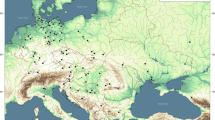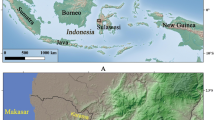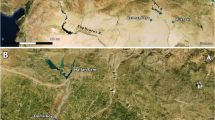Abstract
Wheat is regarded as one of the most important West Asian domesticates that were introduced into Late Neolithic/Early Bronze Age China. Despite a growing body of archaeological data, the timing and routes of its dispersal remain controversial. New radiocarbon (14C) dating evidence from six archaeological sites in the Shandong and Liaoning Peninsulas and Bayesian modelling of available 14C data from China suggest that wheat appeared in the lower Yellow River around 2600 Before Common Era (bce), followed by Gansu and Xinjiang around 1900 bce and finally occurred in the middle Yellow River and Tibet regions by 1600 bce. These results neither support long-standing hypotheses of a progressive spread of wheat agriculture from Xinjiang or Gansu to eastern China nor suggest a nearly synchronous appearance in this vast zone, but corroborate transmission to lower Yellow River elites as an exotic good through cultural interactions with the Eurasian steppe along north–south routes.
This is a preview of subscription content, access via your institution
Access options
Access Nature and 54 other Nature Portfolio journals
Get Nature+, our best-value online-access subscription
$29.99 / 30 days
cancel any time
Subscribe to this journal
Receive 12 digital issues and online access to articles
$119.00 per year
only $9.92 per issue
Buy this article
- Purchase on Springer Link
- Instant access to full article PDF
Prices may be subject to local taxes which are calculated during checkout




Similar content being viewed by others
Change history
08 June 2018
In the version of this Article originally published, the x and y axis labels in Fig. 1 were switched over; the correct labels are: ‘Longitude (° N)’ on the x axis, and ‘Latitude (° E)’ on the y axis. This figure has now been amended in all versions of the Article.
References
Zohary, D., Hopf, M. & Weiss, E. Domestication of Plants in the Old World: The Origin and Spread of Domesticated Plants in Southwest Asia, Europe, and the Mediterranean Basin 4th edn (Oxford Univ. Press, Oxford, 2012).
Coward, F., Shennan, S., Colledge, S., Conolly, J. & Collard, M. The spread of Neolithic plant economies from the Near East to northwest Europe: a phylogenetic analysis. J. Archaeol. Sci. 35, 42–56 (2008).
Flad, R., Li, S., Wu, X. & Zhao, Z. Early wheat in China: results from new studies at Donghuishan in the Hexi Corridor. Holocene 20, 955–965 (2010).
Dodson, J. R. et al. Origin and spread of wheat in China. Quat. Sci. Rev. 72, 108–111 (2013).
Barton, L. & An, C.-B. An evaluation of competing hypotheses for the early adoption of wheat in East Asia. World Archaeol. 46, 775–798 (2014).
Boivin, N., Fuller, D. Q. & Crowther, A. Old World globalization and the Columbian exchange: comparison and contrast. World Archaeol. 44, 452–469 (2012).
Liu, X. & Jones, M. K. Food globalisation in prehistory: top down or bottom up? Antiquity 88, 956–963 (2014).
Zhao, Z. New archaeobotanic data for the study of the origins of agriculture in China. Curr. Anthropol. 52, 295–306 (2011).
Zhou, L. & Garvie-Lok, S. J. Isotopic evidence for the expansion of wheat consumption in northern China. Archaeol. Res. Asia 4, 25–35 (2015).
Warburton, D. A. in Interweaving Worlds: Systemic Interactions in Eurasia, 7th to 1st Millennia BC (eds Wilkinson, T. C., Sherratt, S. & Bennet, J.) 120–134 (Oxbow Books, Oxford, 2011).
Li, J. The landscape of China’s participation in the Bronze Age Eurasian network. J. World Prehist. 28, 179–213 (2015).
Chen, X. An archaeological perspective on scale of wheat cultivation during the Chinese early Bronze Age. Agric. Hist. China 3, 3–9 (2016).
Liu, L. The Chinese Neolithic: Trajectories to Early States. (Cambridge Univ. Press, New York, 2004).
Zhao, Z. Eastward spread of wheat into China: new data and new issues. Chin. Archaeol. 9, 1–9 (2009).
Liu, X. et al. The virtues of small grain size: potential pathways to a distinguishing feature of Asian wheats. Quat. Int. 426, 107–119 (2016).
Pearsall, D. M. Paleoethnobotany: A Handbook of Procedures 2nd edn (Academic Press, San Diego, CA, 2000).
Long, T., Wagner, M. & Tarasov, P. E. A Bayesian analysis of radiocarbon dates from prehistoric sites in the Haidai Region, East China, for evaluation of the archaeological chronology. J. Archaeol. Sci. Rep. 12, 81–90 (2017).
Luan, F. Archaeology of Haidai Region, China (Shandong Univ. Press, Jinan, 1997).
Liu, L. & Chen, X. The Archaeology of China: From the Late Paleolithic to the Early Bronze Age (Cambridge Univ. Press,New York, 2012).
Keepax, C. Contamination of archaeological deposits by seeds of modern origin with particular reference to the use of flotation machines. J. Archaeol. Sci. 4, 221–229 (1977).
Spengler, R. N., Cerasetti, B., Tengberg, M., Cattani, M. & Rouse, L. M. Agriculturalists and pastoralists: Bronze Age economy of the Murghab alluvial fan, southern Central Asia. Veg. Hist. Archaeobot. 23, 805–820 (2014).
Spengler, R. N., Frachetti, M. D. & Doumani, P. N. Late Bronze Age agriculture at Tasbas in the Dzhungar Mountains of eastern Kazakhstan. Quat. Int. 348, 147–157 (2014).
Frachetti, M. D., Spengler, R. N., Fritz, G. J. & Mar’yashev, A. N. Earliest direct evidence for broomcorn millet and wheat in the central Eurasian steppe region. Antiquity 84, 993–1010 (2010).
Gansu Provincial Institute of Cultural Relics and Archaeology, Research Office of Archaeology of the North at Jilin Universtiy. Excavation Report of the Donghuishan Site in Minle: Excavation and Study on the Cemetery of Siba Culture (Science Press, Beijing, 1998).
Zhao, Z. Introduction of wheat to China: archaeobotanical data. Relics South 3, 44–52 (2015).
Jin, G. Y. et al. in Science for Archaeology Vol. 3 (ed. Chinese Academy of Social Sciences) 37–53 (Science Press, Beijing, 2011).
Dong, G., Yang, Y., Han, J., Wang, H. & Chen, F. Exploring the history of cultural exchange in prehistoric Eurasia from the perspectives of crop diffusion and consumption. Sci. China Earth Sci. 60, 1110–1123 (2017).
Song, Y. On two loci on the road of the earliest introduction of wheat into ancient China. Huaxia Archaeol. 2, 31–38 (2016).
Ho, P.-T. in Origins of Agriculture (ed. Reed, C. A.) 413–484 (Mouton Publishers, the Hague, 1977).
Liu, X. et al. Journey to the East: diverse routes and variable flowering times for wheat and barley en route to prehistoric China. PLoS ONE 12, e0187405 (2017).
Betts, A., Jia, P. W. & Dodson, J. The origins of wheat in China and potential pathways for its introduction: a review. Quat. Int. 348, 158–168 (2014).
Charles, M., Forster, E., Wallace, M. & Jones, G. “Nor ever lightning char thy grain”: establishing archaeologically relevant charring conditions and their effect on glume wheat grain morphology. Sci. Technol. Archaeol. Res. 1, 1–6 (2015).
Mei, J. et al. Archaeometallurgical studies in China: some recent developments and challenging issues. J. Archaeol. Sci. 56, 221–232 (2015).
Linduff, K. M. & Mei, J. in Archaeometallurgy in Global Perspective: Methods and Syntheses (eds Roberts, B. W & Thornton, C. P.) 785–803 (Springer, New York, NY, 2014).
Sun, Z. et al. The first Neolithic urban center on China’s north Loess Plateau: the rise and fall of Shimao. Archaeol. Res. Asia https://dx.doi.org/10.1016/j.ara.2017.02.004 (2017).
Rawson, J. Shimao and Erlitou: new perspectives on the origins of the bronze industry in central China. Antiquity 91, e5 (2017).
Hu, S., Yang, M., Sun, Z. & Shao, J. Zooarchaeological remains from the Shimao archaeological site, Shenmu, Shaanxi, 2012-2013. Archaeol. Cult. Relics 4, 109–121 (2016).
Hosner, D., Wagner, M., Tarasov, P. E., Chen, X. & Leipe, C. Spatiotemporal distribution patterns of archaeological sites in China during the Neolithic and BronzeAge: an overview. Holocene 26, 1576–1593 (2016).
Lv, F.-H. et al. Mitogenomic meta-analysis identifies two phases of migration in the history of eastern Eurasian sheep. Mol. Biol. Evol. 32, 2515–2533 (2015).
Lightfoot, E., Liu, X. & Jones, M. K. Why move starchy cereals? A review of the isotopic evidence for prehistoric millet consumption across Eurasia. World Archaeol. 45, 574–623 (2013).
Ma, M. et al. Dietary shift after 3600 cal yr bp and its influencing factors in northwestern China: evidence from stable isotopes. Quat. Sci. Rev. 145, 57–70 (2016).
Liu, X. et al. From necessity to choice: dietary revolutions in West China in the second millennium bc. World Archaeol. 46, 661–680 (2014).
Zhou, X., Li, X., Dodson, J. & Zhao, K. Rapid agricultural transformation in the prehistoric Hexi Corridor, China. Quat. Int. 426, 33–41 (2016).
Dong, G. et al. Prehistoric trans-continental cultural exchange in the Hexi Corridor, northwest China. Holocene https://dx.doi.org/10.1177/095968361773558 (2017).
Ma, Y. et al. Isotopic perspectives (δ13C, δ15N, δ34S) of diet, social complexity, and animal husbandry during the proto-Shang period (ca. 2000–1600 bc) of China. Am. J. Phys. Anthr. 160, 433–445 (2016).
Hayden, B. The proof is in the pudding: feasting and the origins of domestication. Curr. Anthropol. 50, 597–601 (2009).
Jin, G., Wu, W., Zhang, K., Wang, Z. & Wu, X. 8000-year old rice remains from the north edge of the Shandong Highlands, East China. J. Archaeol. Sci. 51, 34–42 (2014).
Wu, W., Wang, X., Wu, X., Jin, G. & Tarasov, P. E. The early Holocene archaeobotanical record from the Zhangmatun site situated at the northern edge of the Shandong Highlands, China. Quat. Int. 348, 183–193 (2014).
Sun, B. in A Companion to Chinese Archaeology (ed. Underhill, A. P.) 435–458 (Wiley-Blackwell, Chichester, 2013).
Archaeometallurgy Group (BUIST) Beijing University of Iron and Steel Technology. A preliminary study of early Chinese copper and bronze artifacts. Acta Archaeol. Sin. 3, 287–302 (1981).
Goslar, T., Czernik, J. & Goslar, E. Low-energy 14C AMS in Poznań Radiocarbon Laboratory, Poland. Nucl. Instrum. Methods Phys. Res. B 223 – 224, 5–11 (2004).
Reimer, P. J. et al. IntCal13 and MARINE13 radiocarbon age calibration curves 0–50,000 years cal bp. Radiocarbon 55, 1869–1887 (2013).
Bronk Ramsey, C. Radiocarbon calibration and analysis of stratigraphy: the OxCal program. Radiocarbon 37, 425–430 (1995).
Li, X., Dodson, J., Zhou, X., Zhang, H. & Masutomoto, R. Early cultivated wheat and broadening of agriculture in Neolithic China. Holocene 17, 55–56 (2007).
Long, T., Hunt, C. O. & Taylor, D. Radiocarbon anomalies suggest late onset of agricultural intensification in the catchment of the southern part of the Yangtze Delta, China. Catena 147, 586–594 (2016).
Dong, G.-H. et al. A comparative study of 14C dating on charcoal and charred seeds from late Neolithic and Bronze Age sites in Gansu and Qinghai provinces, NW China. Radiocarbon 56, 157–163 (2014).
Bronk Ramsey, C. Bayesian analysis of radiocarbon dates. Radiocarbon 51, 337–360 (2009).
Blockley, S. P. E. & Pinhasi, R. A revised chronology for the adoption of agriculture in the Southern Levant and the role of Lateglacial climatic change. Quat. Sci. Rev. 30, 98–108 (2011).
The Institute of Archaeology of the Chinese Academy of Social Sciences. Radiocarbon Dates in Chinese Archaeology (1965–1991) (Cultural Relic Press, Beijing, 1991).
Bronk Ramsey, C. Dealing with outliers and offsets in radiocarbon dating. Radiocarbon 51, 1023–1045 (2009).
Acknowledgements
Research grants from the German Archaeological Institute, Gerda Henkel Stiftung (grant no. AZ 06/F/17), Deutsche Forschungsgemeinschaft (grant no. LE 3508/1-1), National Basic Research Program of China (grant no. 2015CB953803), Shandong University and the National Social Science Fund of China (grant no. 11AZD116, 12&ZD151 and 12&ZD194) are gratefully acknowledged. We appreciate support from Robert Spengler (Max Planck Institute for the Science of Human History) and Fengshi Luan (Shandong University). Thanks are also extended to colleagues at Poznan Radiocarbon Laboratory, Shandong Institute of Cultural Relics and Archaeology, and Yantai Museum.
Author information
Authors and Affiliations
Contributions
T.L., G.J., M.W. and P.E.T. designed the research. G.J. and R.G. contributed wheat samples from field projects for 14C dating. C.L. measured and photographed the analysed wheat grains. T.L. and P.E.T. constructed the 14C data set and designed the Bayesian chronological model. G.J., R.G., M.W. and O.S. contributed to the introduction, results and discussion sections. T.L., C.L. and P.E.T. wrote the manuscript and generated the figures.
Corresponding author
Ethics declarations
Competing interests
The authors declare no competing interests.
Additional information
Publisher’s note: Springer Nature remains neutral with regard to jurisdictional claims in published maps and institutional affiliations.
Supplementary information
Supplementary Information
Background archaeological information, Bayesian model structure and OxCal code, and OxCal modelling results (including Supplementary Figures 1–2 and Supplementary Table 1)
Supplementary Table 2
Size (length, width) of charred wheat grains from different regions of Asia and specimens (Shandong) presented in the current study used for comparison in Fig. 2.
Supplementary Table 3
A dataset of wheat-grain-based 14C dates from China.
Rights and permissions
About this article
Cite this article
Long, T., Leipe, C., Jin, G. et al. The early history of wheat in China from 14C dating and Bayesian chronological modelling. Nature Plants 4, 272–279 (2018). https://doi.org/10.1038/s41477-018-0141-x
Received:
Accepted:
Published:
Issue Date:
DOI: https://doi.org/10.1038/s41477-018-0141-x
This article is cited by
-
Population genomics unravels the Holocene history of bread wheat and its relatives
Nature Plants (2023)
-
Dispersed emergence and protracted domestication of polyploid wheat uncovered by mosaic ancestral haploblock inference
Nature Communications (2022)
-
Between Cereal Agriculture and Animal Husbandry: Millet in the Early Economy of the North Pontic Region
Journal of World Prehistory (2022)
-
Dispersal of crop-livestock and geographical-temporal variation of subsistence along the Steppe and Silk Roads across Eurasia in prehistory
Science China Earth Sciences (2022)
-
New evidence for supplementary crop production, foddering and fuel use by Bronze Age transhumant pastoralists in the Tianshan Mountains
Scientific Reports (2021)



